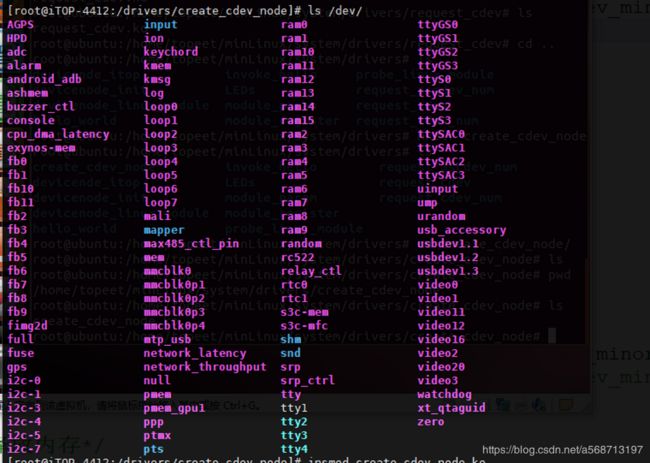4412开发板学习之Linux驱动开发(七):字符设备驱动的基本操作(生成设备节点、编写设备驱动)
字符设备驱动的基本操作(生成设备节点、编写设备驱动)
- 生成字符类设备节点
- 设备类的概念
- 生成字符类设备节点
- 相关函数、结构体及头文件
- 实验
- 代码
- 代码分析
- 实验效果
- 编写字符驱动
- 说明
- 实验
- 代码
- 代码分析
- 实验效果
生成字符类设备节点
设备类的概念
前面介绍的设备中的模型:bus,device,driver都是有比较明确的定义,bus代表总线,device代表实际的设备和接口,driver代表驱动
class是设备类,它是一个抽象的概念,没有对应的实体,它是提供给用户接口相似的一类设备的集合。常见的有输入子系统input、usb、串口tty、块设备block等
misc杂项设备class这个部分,系统对这部分进行了打包
使用ls /sys/class查看设备类

生成字符类设备节点
相关函数、结构体及头文件
-
函数class_create创建class类文件
#define class_create(owner, name)
参数1:一般是THIS_MODULE
参数2:设备名称
返回一个设备类,用于设备节点文件的创建
返回一个class结构体变量 -
class结构体变量
class是设备驱动模型中通用的设备类结构
在include/linux/device.h中
struct class {
const char *name;
struct module *owner;
struct class_attribute *class_attrs;
struct device_attribute *dev_attrs;
struct bin_attribute *dev_bin_attrs;
struct kobject *dev_kobj;
int (*dev_uevent)(struct device *dev, struct kobj_uevent_env *env);
char *(*devnode)(struct device *dev, mode_t *mode);
void (*class_release)(struct class *class);
void (*dev_release)(struct device *dev);
int (*suspend)(struct device *dev, pm_message_t state);
int (*resume)(struct device *dev);
const struct kobj_ns_type_operations *ns_type;
const void *(*namespace)(struct device *dev);
const struct dev_pm_ops *pm;
struct subsys_private *p;
};
- 老版本:创建设备class函数class_device_create
头文件:include/linux/device.h
参数1:class结构体变量
参数2:父设备NULL
参数3:dev_t设备号
参数4:数据NULL
参数5:设备节点名称 - 释放设备class函数class_destroy
extern void class_destroy(struct class *cls);
参数1:myclass - 创建设备节点函数device_create
头文件:include/linux/device.h
extern struct device *device_create(struct class *cls, struct device *parent,dev_t devt, void *drvdata,const char *fmt, …)attribute((format(printf, 5, 6)));
参数1:设备所属的类
参数2:设备的父设备,NULL
参数3:设备号
参数4:设备数据,NULL
参数5:设备名称 - 摧毁设备节点函数device_destory
参数1:设备所属于的类
参数2:设备号 - 加载模块的时候还可以使用命令生成设备节点(老的方法,用的少了,知道就好)
mknod dev/test0 c 249 0
两数字分别为主设备号和次设备号,文件名为节点名
实验
代码
#include 代码分析
这个代码是在前面注册设备的代码的基础上修改的,修改的地方并不多,只是添加了类的注册与释放以及在初始化时生成设备节点,在最后卸载模块的时候摧毁设备节点
在使用循环对设备进行初始化时,每注册一个设备就生成一个一个设备节点
/*生成设备节点*/
device_create(myclass,NULL, MKDEV(numdev_major,numdev_minor+i),NULL,DEVICE_NEME"%d",i);
myclass是我们先前注册的字符设备类
父设备写NULL
dev_t设备号我们使用MKDEV宏定义来生成(高12为主设备号,低20位为次设备号)
数据写NULL
设备节点名称我们使用DEVICE_NEME加数字后缀,生成的应当是chardevnode0、chardevnode1…
在我们卸载模块的时候我们释放了申请的内存空间、释放了设备类、摧毁了生成的设备节点
实验效果
首先我们查看一下设备类和设备节点


加载模块

查看设备类

![]()
生成了chardevnode设备类
查看设备节点


生成了我们想要的两个设备节点
卸载模块
![]()
编写字符驱动
说明
编写字符驱动与我们前面所做的编写杂项设备驱动的工作相同,就是给文件操作系统调用open、close、ioctl实现底层的操作,也就是实现file_operations中的部分函数
- 打开函数
int (*open) (struct inode *, struct file *) - 释放close函数
int (*release) (struct inode *, struct file *) - io控制函数
long (*unlocked_ioctl) (struct file *, unsigned int, unsigned long) - 读函数
ssize_t (*read) (struct file *, char __user *, size_t, loff_t *) - 写函数
ssize_t (*write) (struct file *, const char __user *, size_t, loff_t *) - 定位函数
loff_t (*llseek) (struct file *, loff_t, int)
如果需要不同的设备节点有不同的功能,只需要在注册设备的时候添
加不同的file_operations结构体即可
实验
代码
驱动代码
#include 应用程序代码
#include 代码分析
- 驱动代码
在驱动代码中我们实现了上面提到的六个函数,当然我们只是写了很简单的打印,表示驱动正确的进入了这些函数
在chardevnode_open、chardevnode_release函数中我们写了打印信息,所以当应用程序调用open和close函数的时候将会有打印信息
我们在chardevnode_ioctl函数中打印了指令和参数,当我们调用ioctl函数时将把它的参数打印出来
我们定义了file_operations结构体类型的my_fops来注册驱动的各种功能 - 应用代码
在应用代码中我们做了很简单的事情,我们分别使用open来打开设备节点,然后使用ioctl进行操作,最后使用close关闭设备节点


